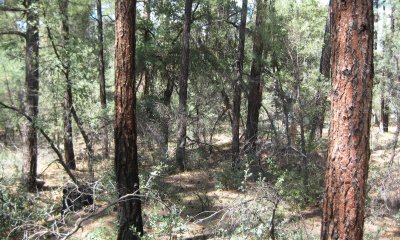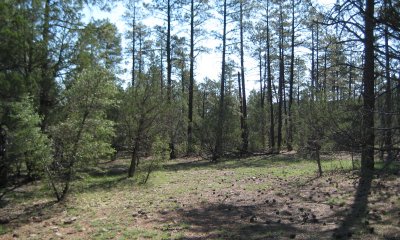
Ponderosa Pine - Gray Oak Forest 20-25" p.z. (PIPO, QUGR3)
Scenario model
Current ecosystem state
Select a state
Management practices/drivers
Select a transition or restoration pathway
- Transition T1a More details
- Transition T1b More details
- Transition T1c More details
- Transition T2a More details
- Restoration pathway R2a More details
- Restoration pathway R3b More details
- Restoration pathway R3a More details
- Transition T3a More details
- Restoration pathway R4a More details
- Transition T4a More details
- Restoration pathway R5b More details
- Restoration pathway R5a More details
-
No transition or restoration pathway between the selected states has been described
Target ecosystem state
Select a state
Description
The Reference State is a low (10-15%) to Medium (45-55%)canopy cover forest with herbaceous production ranging from 1900-2000 lbs/ac with low tree canopy cover to 750-850 lbs/ac with medium tree canopy cover.
Submodel
Description
Ponderosa pine canopy ranges from 10-55%. Sideoats grama and often times cool season grasses are severely reduced and replaced by blue grama.
Submodel
Description
Alligator juniper increases in number of trees per acre and canopy cover.
Submodel
Description
Tree canopy cover increases to approximately 75%. Herbaceous production is reduced to approximately 500 lbs/ac.
Submodel
Mechanism
Continuous high intensity livestock or wildlife herbivory reduces most perennial grass vigor to the point that blue grama being highly tolerant of heavy herbivory is the dominant grass species.
Mechanism
The long term absence of fire either through aggressive fire suppression or heavy herbivory reducing fine fuel continuity allows juniper to germinate and grow to maturity. In most cases this occurs at the lowest elevations of the site where ponderosa pine forests are adjacent to alligator juniper savannas (Ecological Site number R038XC303AZ). However, where any seed dispersal mechanism is in place, this can occur throughout the sites elevation range. The invasion by juniper can become self perpetuating if fires are not allowed to burn the site and kill young individuals as is common for most woody species in mixed grass/woody plant communities adapted to periodic fire.
Mechanism
The long term absence of fire either through aggressive fire suppression or heavy herbivory reducing fine fuel continuity allows ponderosa pine to germinate and grow to maturity. Historic fires regularly reduced this germination though direct mortality by consuming significant portions of above ground tissue. There is some research that suggests very high density and productive herbaceous understory plant communities out compete woody species seedlings, however frequent fire alone as documented in trees ring fire scars would have been sufficient to kill most regeneration. As seen in Figures 1 and 2 of Community 1.2. , herbaceous production and continuity is typically severely restricted near the base of very large diameter trees. As these trees died of old age this environment very likely could have provided favorable germination locations for replacement trees that would have a micro site where fire intensities would have been lower than adjacent areas with high fine fuel continuity.
Mechanism
The long term exclusion of fire allows juniper to germinate and often times reach sexual maturity and develop 15-20% canopy cover.
Mechanism
This restoration pathway is unknown. In blue grama dominated grasslands surrounding Springerville, AZ the competitive nature of blue grama sod is only broken and other species are allowed to establish where livestock pipelines have been ripped into the soil. Similar dynamics were observed in the Quemado, NM area. Ripping, where practical, between thinned stands & seeding may be the only potential restoration pathway.
Mechanism
This restoration pathway has not been applied and is inferred based on overall vegetation structural similarities. The only vegetation difference is sideoats grama is still dominant in the plant community and is not negatively affected by fire. Fall application of prescribed fire to prevent fire from spreading into upper ponderosa pine canopies.
Mechanism
The application of prescribed fire in the fall where juniper trees have approached 15-20 feet in height and are near the lower canopy of younger ponderosa pine trees reduces the ability of fire to spread into the upper forest canopy. Blue grama is the dominant herbaceous species and maintains its dominance following application of fire.
Transition T3a


Mechanism
The long term exclusion of fire allows juniper and ponderosa pine to germinate and often times reach sexual maturity. Juniper canopy cover approaches 15-20% and ponderosa pine canopy approaches 75+%. This level of shading and likely competition reduces herbaceous production of most areas to less than 25 lbs/ac.
Restoration pathway R4a


Mechanism
Application of forest stand improvement followed by the incremental removal of pine leaf litter or duff by burning when trees are dormant (late fall) and when deeper layers of duff are moist significantly reduces the chance that fine roots will be destroyed in southwestern ponderosa pine forests (Egan 2011). This is best accomplished by several burns over a period of a decade; the first 1-2 burns spaced 4 years apart (Egan 2011).
Transition T4a


Mechanism
Continued dominance of ponderosa pine reduces the ability of the herbaceous understory to persist.
Restoration pathway R5b


Mechanism
Application of forest stand improvement (forest thinning) followed by the incremental removal of pine leaf litter or duff by burning when trees are dormant (late fall) and when deeper layers of duff are moist significantly reduces the chance that fine roots will be destroyed in southwestern ponderosa pine forests (Egan 2011). This is best accomplished by several burns over a period of a decade; the first 1-2 burns spaced 4 years apart (Egan 2011). Top killing of alligator juniper without the application of stump herbicide may allow it to persist in the community if fire is not effective at killing it. Seeding after O horizon or mineral soil is exposed is required to reestablish the herbaceous understory vegetation.
Restoration pathway R5a


Mechanism
Application of forest stand improvement (forest thinning) followed by the incremental removal of pine leaf litter or duff by burning when trees are dormant (late fall) and when deeper layers of duff are moist significantly reduces the chance that fine roots will be destroyed in southwestern ponderosa pine forests (Egan 2011). This is best accomplished by several burns over a period of a decade; the first 1-2 burns spaced 4 years apart (Egan 2011). The application of stump herbicide to cut juniper immediately after cutting will kill most plants. Rates of application should be obtained from herbicide manufacturers. Seeding after O horizon or mineral soil is exposed is required to reestablish the herbaceous understory vegetation.
Model keys
Briefcase
Add ecological sites and Major Land Resource Areas to your briefcase by clicking on the briefcase (![]() ) icon wherever it occurs. Drag and drop items to reorder. Cookies are used to store briefcase items between browsing sessions. Because of this, the number of items that can be added to your briefcase is limited, and briefcase items added on one device and browser cannot be accessed from another device or browser. Users who do not wish to place cookies on their devices should not use the briefcase tool. Briefcase cookies serve no other purpose than described here and are deleted whenever browsing history is cleared.
) icon wherever it occurs. Drag and drop items to reorder. Cookies are used to store briefcase items between browsing sessions. Because of this, the number of items that can be added to your briefcase is limited, and briefcase items added on one device and browser cannot be accessed from another device or browser. Users who do not wish to place cookies on their devices should not use the briefcase tool. Briefcase cookies serve no other purpose than described here and are deleted whenever browsing history is cleared.
Ecological sites
Major Land Resource Areas
The Ecosystem Dynamics Interpretive Tool is an information system framework developed by the USDA-ARS Jornada Experimental Range, USDA Natural Resources Conservation Service, and New Mexico State University.











